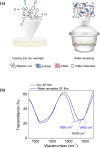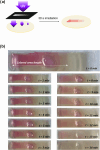Reusable Colorimetric Biosensors on Sustainable Silk-Based Platforms
- PMID: 38270977
- PMCID: PMC10880051
- DOI: 10.1021/acsabm.3c00872
Reusable Colorimetric Biosensors on Sustainable Silk-Based Platforms
Abstract
In biosensor development, silk fibroin is advantageous for providing transparent, flexible, chemically/mechanically stable, biocompatible, and sustainable substrates, where the biorecognition element remains functional for long time periods. These properties are employed here in the production of point-of-care biosensors for resource-limited regions, which are able to display glucose levels without the need for external instrumentation. These biosensors are produced by photopatterning silk films doped with the enzymes glucose oxidase and peroxidase and photoelectrochromic molecules from the dithienylethene family acting as colorimetric mediators of the enzymatic reaction. The photopatterning results from the photoisomerization of dithienylethene molecules in the silk film from its initial uncolored opened form to its pink closed one. The photoisomerization is dose-dependent, and colored patterns with increasing color intensities are obtained by increasing either the irradiation time or the light intensity. In the presence of glucose, the enzymatic cascade reaction is activated, and peroxidase selectively returns closed dithienylethene molecules to their initial uncolored state. Color disappearance in the silk film is proportional to glucose concentration and used to distinguish between hypoglycemic (below 4 mM), normoglycemic (4-6 mM), and hyperglycemic levels (above 6 mM) by visual inspection. After the measurement, the biosensor can be regenerated by irradiation with UV light, enabling up to five measurement cycles. The coupling of peroxidase activity to other oxidoreductases opens the possibility to produce long-life reusable smart biosensors for other analytes such as lactate, cholesterol, or ethanol.
Keywords: colorimetric biosensor; dithienylethene mediators, photopatterning; glucose detection; photoelectrochromic; point of care; silk fibroin.
Conflict of interest statement
The authors declare no competing financial interest.
Figures







References
-
- Meggi B.; Bollinger T.; Mabunda N.; Vubil A.; Tobaiwa O.; Quevedo J. I.; Loquiha O.; Vojnov L.; Peter T. F.; Jani I. V. Point-Of-Care P24 Infant Testing for HIV May Increase Patient Identification despite Low Sensitivity. PLoS One 2017, 12 (1), e016949710.1371/journal.pone.0169497. - DOI - PMC - PubMed
-
- Mabey D. C.; Sollis K. A.; Kelly H. A.; Benzaken A. S.; Bitarakwate E.; Changalucha J.; Chen X.-S.; Yin Y.-P.; Garcia P. J.; Strasser S.; Chintu N.; Pang T.; Terris-Prestholt F.; Sweeney S.; Peeling R. W. Point-of-Care Tests to Strengthen Health Systems and Save Newborn Lives: The Case of Syphilis. PLoS Med. 2012, 9 (6), e100123310.1371/journal.pmed.1001233. - DOI - PMC - PubMed
Publication types
MeSH terms
Substances
LinkOut - more resources
Full Text Sources
